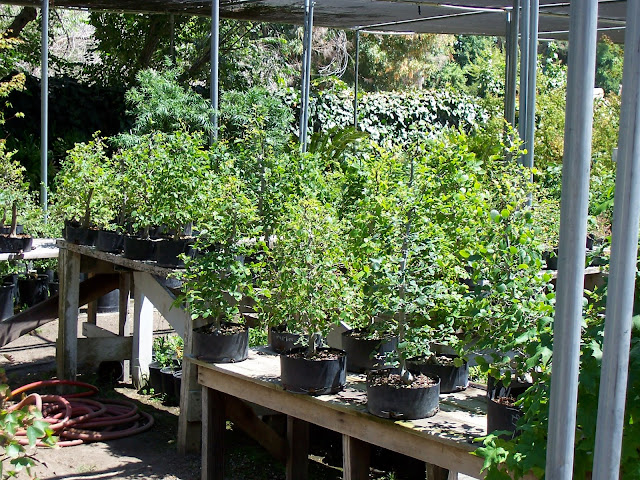Before we get to today's subject I want to announce our annual Dog Days of Summer Sale here at Kimura Nursery from now until Labor day. Everything is 10-25% off with some items such as in-stock bamboo at 50% off. So come on in -just in time to stock up for fall transplanting or that new fall project tree.
Today I want to talk about defoliation, what is it, and why we do it. The tree I'll be using to demonstrate on is a Narrow Leaf Ficus that is about 15-16 years old from a cutting. The tree has some inherent problems as a bonsai; some I can work with, others I have to live with. The biggest problems are the two lower branches. These are known as bar branches and can be problematic - with so much of the tree's energy being pulled into one area, the likelihood of reverse taper is great. If I were to just cut one off it would be even worse than doing nothing. It would effectively ruin the tree as a bonsai. Luckily, the base below these two branches being is as big as it is cuts down on the possibility of that happening before I can do something to correct the problem. I am considering doing what is known as a thread graft above those two to help create taper in the trunk and as a possible future replacement for one of the bar branches. I'm also considering an approach graft instead. One of these will be the subject of a future blog if I do it.
Defoliation is removing (in this case) all of the leaves of a tree. It can be done on most healthy deciduous and broadleaf evergreen trees. The main benefit of defoliation is that it very often helps to increase ramification. It also helps reduce the size of the next crop of leaves. It allows air and light to penetrate to the interior of the tree and to stimulate those buds that create the new ramification. It also makes it much easier to wire. I have to stress though that it can be very taxing on a tree to defoliate it so it is imperative any tree that you do this to is healthy and growing vigorously.
Here is the tree before any of the work. As you can see the root base is impressive and gives the appearance of an old powerful tree.
You can really see the bar branches here, as well as a better shot of the nebari.
The trunk above the two branches doesn't have any taper from above them until about 2/3rds of the way up the tree, which is one reason I'm considering a graft . In this next image the wiring has started and the tree is completely defoliated. The wiring is time consuming because I'm wiring just about every branch and twig on the tree.
Here is a shot looking down from the top. There is a bunch of wire on this tree! Since we still have a couple of months of active growing here I'll start checking the wire in about 30 days and will keep an eye on it so it doesn't scar.
Another shot of the wiring detail.
This is what we have at the end of all of this phase of the work:
That's it for todays post. As usual, comments and suggestions are always welcome.
And don't forget the sale through Labor Day at Kimura Bonsai Nursery - come on by!
















































